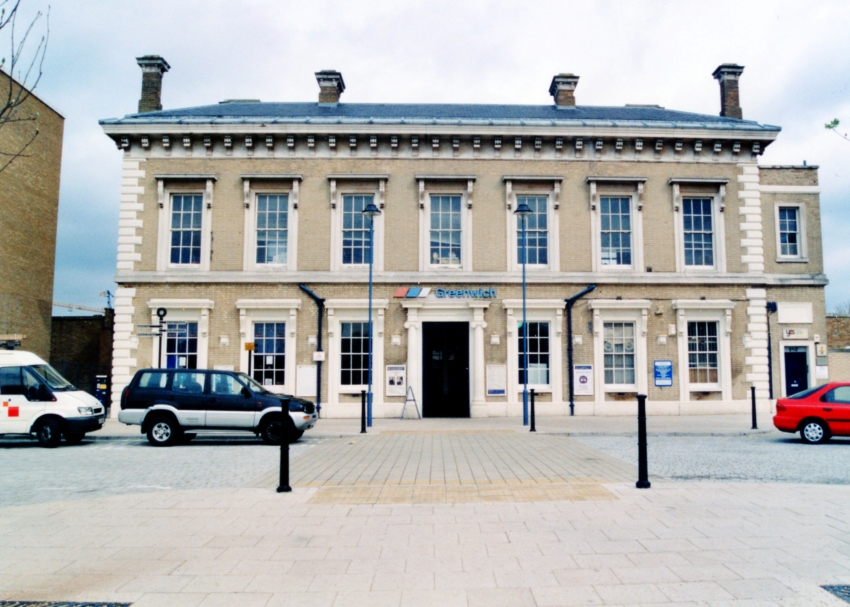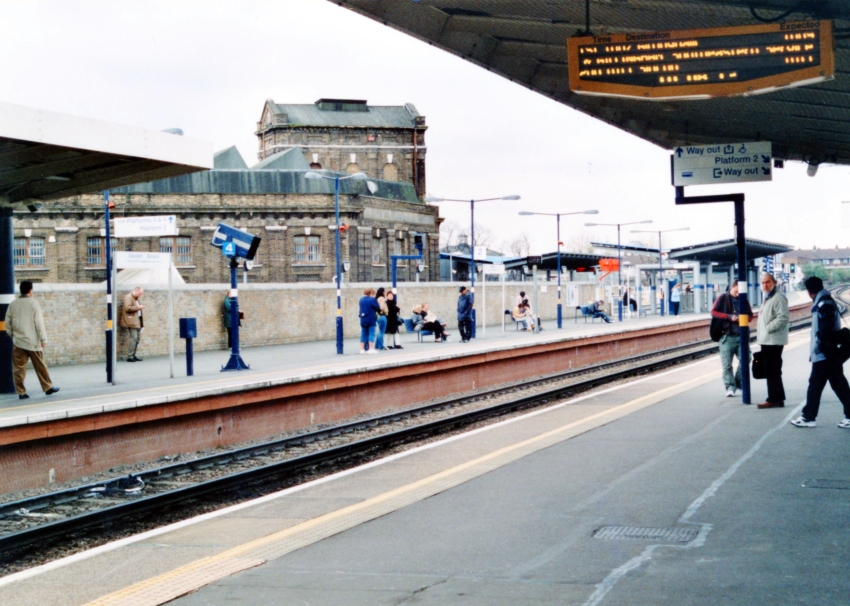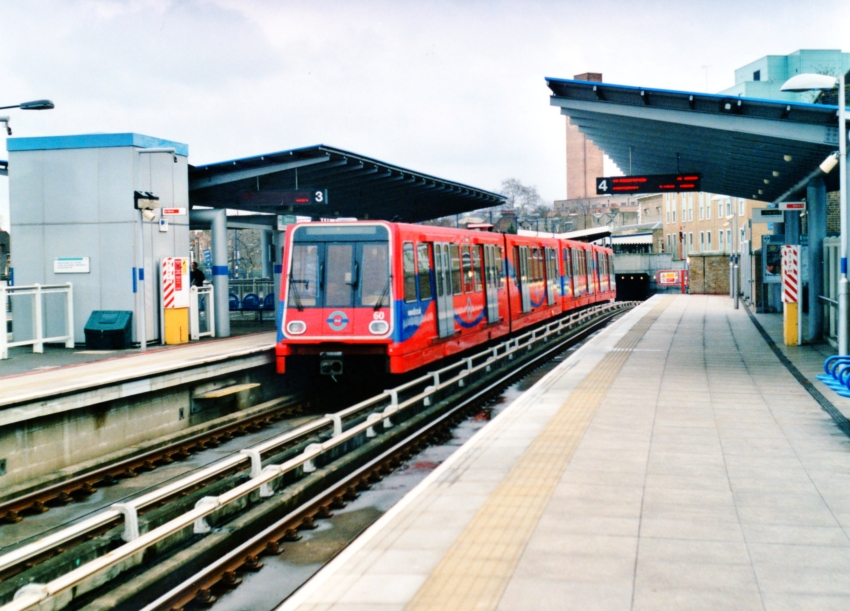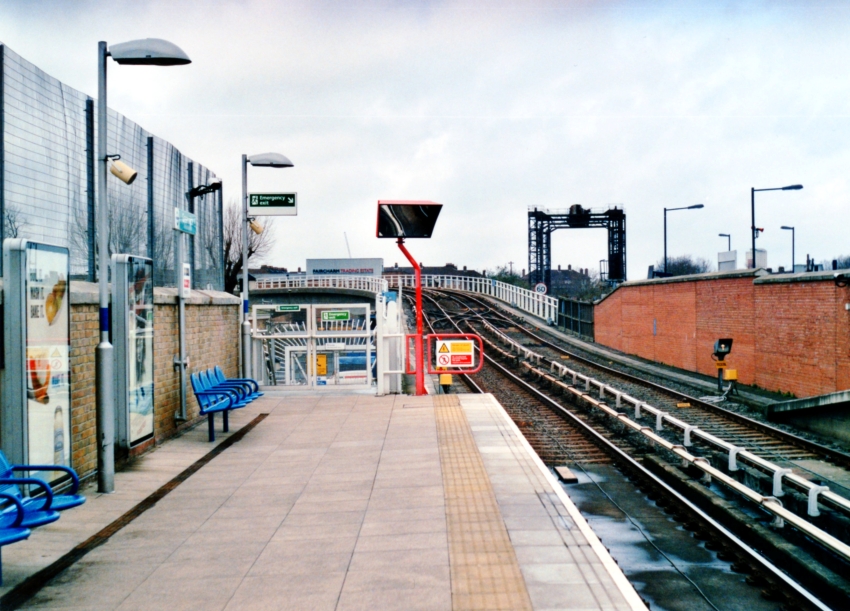Greenwich
The overall roof had given way to standard platform canopies, but the latter were still ornate, with clover-patterned timber valances, and were supported upon cast-iron stanchions. A layout of two platform faces separated by four tracks, not unlike those at Canterbury and Gravesend, was retained, but as per the previous station, no goods yard was evident. Both platforms were of timber construction and a subway provided passage between them. The through route came into use to scheduled passenger traffic on 1st February 1878:
In February, 1878, the short, but heavy link connecting it with the Maze Hill-Charlton line was brought into use, and the old viaduct was thenceforward plied over by the 185 and every other type of coupled passenger and goods engine on the S.E.R. The steep gradient of 1 in 60 at Greenwich effectually shut out the "Mail" and other single–driver engines. [The First Railway in London: Being the Story of the London and Greenwich Railway from 1832 to 1878, Alfred Rosling Bennett, 1912]
Signal boxes were positioned to the west and east of the platforms, both two-storeys high and to the SER's typical design of timber construction with sash-style windows. These were both superseded in about 1910 by a single, much larger cabin, three-storeys high, positioned at the western end of the layout. It was presumably built to this height to afford the signalman an unobstructed view across the whole layout, above the platform canopies, now that it was undertaking the work of two former cabins.
Economies at this spacious station were enacted by the Southern Railway as a prelude to electrification of ex-SE&CR suburban lines. In 1924, the two centre tracks were lifted, given that little non-stop traffic passed through. All North Kent routes to Dartford were equipped with third rail; for the Greenwich line, this involved laying an underwater cable for the electricity supply across Deptford Creek, given that the bridge across it was moveable for the passage of vessels. Regular scheduled electric services commenced through to Dartford on 6th June 1926. At this stage, Cannon Street was closed for extensive track and platform remodeling work, so Charing Cross and London Bridge were under increased strain to take these services. It was deemed that diversions from Cannon Street to these stations were more easily managed with electric units, rather than steam trains.
On the other side of the creek, the SR re-opened Deptford station on 19th July 1926, which had closed as a wartime economy in 1915. On 1st December 1929, colour aspect lights came into use between Spa Road and Greenwich, controlled from a signal box at North Kent East Junction, where the North Kent Line via Lewisham and Greenwich route diverge. The signal box and associated semaphores at Greenwich were retained, but the former was subsequently taken out of use in February 1934. In the same decade the SR rebuilt the timber platforms using prefabricated concrete, and the lengthy canopies on both sides were cut back to less than half of their original length. The decorative SER canopy valances were replaced at the same time with a plain timber variant, and the platform areas formerly covered by the canopies had Swan Neck lamps installed.
In 1954, under British Railways, the platforms were extended at their western ends with prefabricated concrete. This was part of the ten-car train scheme, which aimed to ease congestion on South Eastern Division suburban lines after the decision not to pursue further builds of double-decker trains. Semaphore signals at Greenwich were superseded by colour aspect lights on 8th March 1970, when the line from there to Westcombe Park was converted.
In 1988, a much-welcomed refurbishment of Greenwich station was completed, which included the cosmetic restoration of the main building's brickwork and the installation of an SER-style valance on the "up" platform canopy. The "down" canopy was demolished at this time.
In 1991, a Parliamentary Bill was deposited for the extension of the Docklands Light Railway from Canary Wharf to Lewisham via Greenwich, this of which received Royal Assent in May 1993. Between "up" and "down" lines at Greenwich still existed the vacant space formerly occupied by the two through tracks lifted by the SR in 1924. To accommodate the new DLR platforms at Greenwich, which were to be situated upon the site then occupied by the western end of the "up" platform, the London-bound track was relayed on a new alignment to the north within this gap. "Up" and "down" tracks were now immediately adjacent to each other, and the London-bound platform was rebuilt on a new alignment, a double-track width further north of its previous location.
Work on the DLR extension included boring a tunnel underneath the Thames between the Isle of Dogs and Cutty Sark, and the provision of a cut-and-cover tunnel underneath the eastern end of Greenwich station. From there, the line ascended underneath the main station building and emerged from darkness behind the western end of the realigned "up" platform.
The DLR line was double-track from the outset and opened through to Lewisham on 22nd November 1999. Greenwich now had four platform faces: two serving the National Rail lines and two dedicated to the DLR. New all-metal "V" shaped canopies were erected on the National Rail platforms, but the main building retained its traditional awning. DLR passengers were protected from the elements by a second set of V-shaped canopies positioned 400-foot west of the 1878 main building.
Finally, in 2005, a new hotel was completed immediately adjacent to the station building's western elevation.
19th April 2006

A similar viewpoint to the previous photograph, but now in the 21st Century, shows a lot of changes. As part of the DLR works, the gap in-between the lines has gone, the "up" track shifted towards the camera, and the London-bound platform extended from the main building to meet it. V-shaped canopies are now present on both sides and the wall on the right, behind the "up" platform, hides the descent of the DLR into a tunnel. The hotel immediately adjacent to the main building dates from 2005. © David Glasspool
19th April 2006

The fine station building, restored in 1988, was still displaying a "Network SouthEast" logo above its main entrance, over a decade after the British Rail business sector's demise. The platforms and tracks of the previous station, replaced in 1878, stood in the foreground, upon what is now the forecourt, and the building pictured was end-on to the rails, as per a typical terminus. The structure was then dismantled brick-by-brick and re-erected beside realigned running lines, which now allowed through running to Charlton. The book referenced much in the main text, "The First Railway in London" [1912], whose author Alfred Rosling Bennett remembers both the pre- and post-1878 Greenwich branch first-hand, states that the main building - save for internal layout - was rebuilt in identical style. Therefore, the building we see today is the same as that opened in 1840, albeit rotated 90 degrees and moved a little further north. However, some lithographs of the 1840 station show the main building to have been shorter than today's, and with a flat rather than hipped roof. © David Glasspool
19th April 2006

Looking towards Deptford, the replacement "up" platform is in view; the two canopies in the right background are those for the DLR tracks, the latter of which descended towards a tunnel behind the wall. © David Glasspool
23rd February 2007

A "B92" four-car automatic electric DLR unit, No. 60. is seen starting the descent into the cut-and-cover tunnel which takes the line through to Cutty Sark. Thereafter, it dives down even further under the Thames to reach the Isle of Dogs. These tracks reside on the former site of the original "up" platform of the National Rail station; the main building can be seen above the tunnel portal in the background. © David Glasspool
23rd February 2007

Looking west, the DLR line is seen climbing towards a concrete viaduct which takes it to the next stop along the line in the Lewisham direction, Deptford Bridge, about 700-yards away. The lifting bridge which carries the National Rail line over Deptford Creek is evident in the right background. © David Glasspool
Return to the Kent Rail Homepage or alternatively, check for Updates.
Website & Copyright information - Links - Contact the Webmaster
